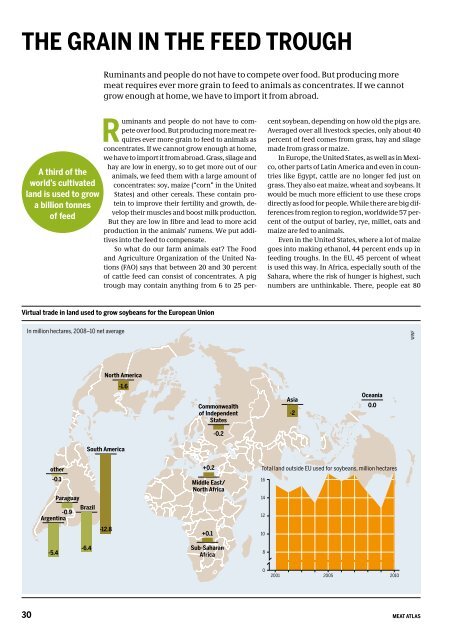THE GRAIN IN THE FEED TROUGHRuminants and people do not have to compete over food. But producing moremeat requires ever more grain to feed to animals as concentrates. If we cannotgrow enough at home, we have to import it from abroad.A third of theworld’s cultivatedland is used to growa billion tonnesof feedRuminants and people do not have to competeover food. But producing more meat requiresever more grain to feed to animals asconcentrates. If we cannot grow enough at home,we have to import it from abroad. G rass, silage andhay are low in energy, so to get more out of ouranimals, we feed them with a large amount ofconcentrates: soy, maize (“corn” in the UnitedStates) and other cereals. These contain proteinto improve their fertility and growth, developtheir muscles and boost milk production.But they are low in fibre and lead to more acidproduction in the animals’ rumens. We put additivesinto the feed to compensate.So what do our farm animals eat? The Foodand Agriculture Organization of the United Nations(FAO) says that between 20 and 30 percentof cattle feed can consist of concentrates. A pigtrough may contain anything from 6 to 25 percentsoybean, depending on how old the pigs are.Averaged over all livestock species, only about 40percent of feed comes from grass, hay and silagemade from grass or maize.In Europe, the United States, as well as in Mexico,other parts of Latin America and even in countrieslike Egypt, cattle are no longer fed just ongrass. They also eat maize, wheat and soybeans. Itwould be much more efficient to use these cropsdirectly as food for people. While there are big differencesfrom region to region, worldwide 57 percentof the output of barley, rye, millet, oats andmaize are fed to animals.Even in the United States, where a lot of maizegoes into making ethanol, 44 percent ends up infeeding troughs. In the EU, 45 percent of wheatis used this way. In Africa, especially south of theSahara, where the risk of hunger is highest, suchnumbers are unthinkable. There, people eat 80Virtual trade in land used to grow soybeans for the European UnionIn million hectares, 2008–10 net averageWWFNorth America-1.6Commonwealthof IndependentStatesAsia-2Oceania0.0-0.2South America+0.2Total land outside EU used for soybeans, million hectaresother-0.1ParaguayBrazil-0.9ArgentinaMiddle East/North Africa161412-12.8+0.110-5.4-6.4Sub-SaharanAfrica802001 2005 201030MEAT ATLAS
percent of the cereal harvest; animals eat whatthey find on pastureland.On a global scale, more than 40 percent ofthe annual output of wheat, rye, oats and maizegoes into animal feed. That is nearly 800 milliontonnes. Add to that another 250 million tonnes ofoilseeds, mainly soybeans. In many regions theseare grown in mass monocultures and exportedworldwide. Soybeans could be replaced by nativelegumes such as beans, peas or lucerne which alsofix nitrogen from the air and return this valuableplant nutrient to the soil. But these crops only accountfor about 20 percent of the protein used infeed in the European Union.Overall, nearly one-third of the world’s 14 billionhectares of cultivated land is used to growanimal feed. If we also count the crop by-productsthat also go into feed, such as straw and seedcakefrom soybeans, rape or grapes, three-quartersof all cropland is used to produce animal feed insome way. And a major study conducted by theUnited Nations on agricultural development estimatesthat livestock production accounts for 70percent of all agricultural land.Feed production has become separated fromanimal raising. Crops intended for feed are nowtransported long distances, often across oceans,to reach the animals. That has consequences: a lotof livestock raisers cannot dispose of the manurenearby in a safe, environmentally friendly manner.They have to ship it somewhere else to bespread on the fields. Meanwhile, the farmers whogrow the feed have to use large amounts of artificialfertilizers and pesticides to get a decent crop.In addition, grain yields have stopped risingin some places. According to a study by theUniversity of Minnesota, yields in one-quarter toone-third of the producing areas are stagnating– including in Australia, Argentina, Guatemala,Morocco, Kenya and the US states of Arkansas andTexas. In parts of the UK, in areas that producedthe highest outputs 20 years ago, yields have actuallydecreased. For wheat and rapeseed, Britishresearchers suspect that this is due to the soilGrassland and scrubland converted to cropland and pasturePercentage of natural inventory converted to cropland pastureSouthAmericaNorthAmericaPacific(developed)EuropeAsia(incl. formerSoviet Union)Africa0 2 4 6 8 10 12previously grassland or savannahdamage caused by the use of heavy machinery. Asa result, there is a continued long-term decline inorganic matter content in British soils.On a global scale, stagnating yields affectfour major grain types that produce two-thirdsof the calories: maize, rice, wheat and soybeans.Yields of these four crops are growing by only0.9 to 1.6 percent a year. The authors of theMinnesota study think this is because effortshave gone into producing livestock feed andbiofuel crops. They argue that more efficientuse of current arable land and better managementregimes across the globe might assuagethe problem, but further expansion of croplandwould bring big environmental costs in the formof biodiversity loss and higher carbon emissions.Deepak Ray, one of the study’s authors, has anothersuggestion: “Perhaps most controversially, wecan change to more plant-based diets.”0 2 4 6 8 10 12previously scrublandFAOExpandingcropland furtherwould cause moredamage to theenvironmentLand for lunchArea of land needed to produce a typical meat dish, in m 2 /personWWF3.613.383.122.230.661.360.760.382.261.960.35total area neededneeded for meatcomponentneeded for soy0.11roast pork hamburger chicken curry grilled sausageMEAT ATLAS31


